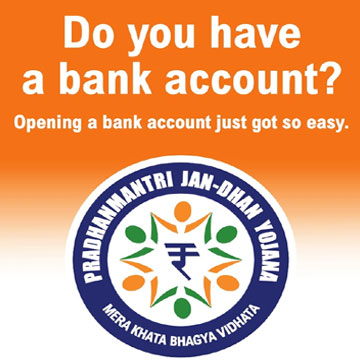 The
The average deposit per account under the Pradhan Mantri Jan Dhan Yojana (PMJDY) - a financial inclusion programme launched by Prime Minister Narendra Modi in August 2014 - increased 118 per cent from Rs 795 in September 2014 to Rs 1,735 in May 2016, according to IndiaSpend analysis of government data.
PMJDY accounts quadrupled (increased by 308 per cent), from 53 million in September 2014 to 219 million in May 2016, while the proportion of accounts with no money in them - zero-balance accounts, as they are called - declined from 76 per cent in 2014 to 25.7 per cent in 2016.
This indicates that more Indians are being included in the formal financial system, and they are willing to keep their earnings in Jan Dhan accounts, along with payments coming in directly to those accounts from the Mahatma Gandhi National Rural Employment Guarantee Act (MGNREGA) and subsidy for liquefied petroleum gas (LPG).
PMJDY deposits increased nearly eight-fold (790 per cent), from Rs 4,273 crore in September 2014 to Rs 38,048 crore in May 2016.
However, the average deposit in accounts apart from those with no money (zero-balance accounts) declined 32 per cent - from Rs 3,427 to Rs 2,333 over the same period - showing that new account holders are putting in less money into their bank accounts than they did.
"One of the basic things said against financial inclusion is that when the poor open bank accounts, the large majority of these accounts are actually zero-balance accounts and there are no transactions," Alok Pande, Director (Financial Inclusion) and Additional Mission Director, PMJDY, said in August 2015. "In camp mode (when depositors were being signed up), banks had tables, a few people, chairs and forms; there was no arrangement for collection of cash, deposit of cash, taking care of cash; so basically accounts were opened in zero-balance mode."
Pande said people were proud to have an identity. "We persuaded banks to issue passbooks. You will not believe the dramatic impact; from about 79 per cent zero-balance accounts in November (2014), zero-balance accounts dropped to 45 per cent(August, 2015)," he said. "One of the major things that created the push was that people love to see their own photograph, name, address in a passbook."
"Direct benefit transfers from the government are coming through these (Jan Dhan) accounts. So, zero-balance accounts have come down automatically as money is put in these accounts," said Madan Sabnavis, Chief Economist, CARE Ratings. "The average balance in non-zero-balance accounts has come down as people withdraw money from it and are still not used to the banking habit. Jan Dhan shows that the challenge for the system is to create this business of banking habit."
"In China, the amount of money that goes through the formal sector (banking) is around 70 per cent and the informal sector (moneylenders) is 30 per cent. The case is exactly opposite in India with only 30 per cent going through the formal sector and 70 per cent through the informal sector," Soumya Kanti Ghosh, chief economic advisor, State Bank of India, told IndiaSpend. "Jan Dhan accounts will channelise these transactions through formal accounts or the banking system, which will help banks to provide the right products to the right person, leading to better financial inclusion."
As subsidy payments through bank accounts rise, fewer accounts will be unused
Zero-balance accounts will decline as subsidy payments increase, said Ghosh.
In 2015-16, the government transferred Rs 61,824 crore ($10 billion) to 310 million beneficiaries of 59 central schemes, such as National Social Assistance Programme, Post Matric Scholarship For Scheduled Tribe, Fellowship Schemes of All India Council for Technical Education and Janani Suraksha Yojana.
India created financial history opening 18 million bank accounts in a week (between August 23 and 29 August, 2014), setting a Guinness World Record.
Lakshadweep has the maximum average bank deposit; J&K has most zero-balance accounts
The island territory of Lakshadweep has the maximum average deposit per account, Rs 8,824, and the maximum average deposit per non-zero-balance account - Rs 12,540.
Mizoram has the least average deposit per account, Rs 646, and the least average deposit per non-zero-balance account -Rs 998.
Jammu and Kashmir had the largest proportion of zero-balance accounts, 41.5 per cent, on May 25, 2016, followed by Chhattisgarh (38 per cent), Nagaland (36.4 per cent), Andaman and Nicobar Islands (35.3 per cent) and Mizoram (35.2 per cent).
Chandigarh has the least zero-balance accounts, 13.9 per cent, followed by Himachal Pradesh (14.6 per cent), Tripura (15 per cent), Goa (16.3 per cent) and Punjab (17.5 per cent).
Financial inclusion accelerates under PMJDY
About 40 per cent of India's population is now outside the purview of formal banking.
Only 145 million households (58.7 per cent) of 247 million in the country had access to banking services, according to Census 2011; 91 million rural households used the banking system, as did 53 million urban households.
As many as 219.3 million PMJDY accounts were opened as on May 25, 2016; 134.7 million are rural and 84.6 million are urban accounts.
# In arrangement with IndiaSpend.org, a data-driven, non-profit, public interest journalism platform, with whom Chaitanya Mallapur is an analyst. The views expressed are those of IndiaSpend. The author can be contacted at respond@indiaspend.org
 The average deposit per account under the Pradhan Mantri Jan Dhan Yojana (PMJDY) - a financial inclusion programme launched by Prime Minister Narendra Modi in August 2014 - increased 118 per cent from Rs 795 in September 2014 to Rs 1,735 in May 2016, according to IndiaSpend analysis of government data.
The average deposit per account under the Pradhan Mantri Jan Dhan Yojana (PMJDY) - a financial inclusion programme launched by Prime Minister Narendra Modi in August 2014 - increased 118 per cent from Rs 795 in September 2014 to Rs 1,735 in May 2016, according to IndiaSpend analysis of government data.